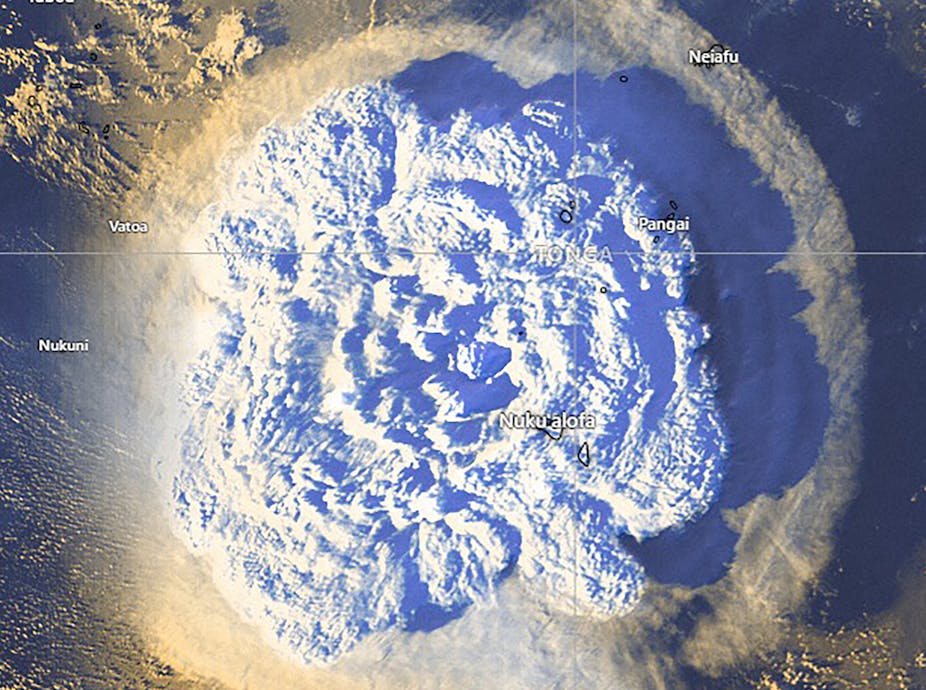
Satellite image of the Tonga explosion. TONGA METEOROLOGICAL SERVICES/EPA
The ongoing volcanic eruption in Tonga began in December 2021, but it wasn’t until 5:15pm local time on January 15 2022 that the powerful explosion occurred. It generated an enormous cloud of ash, earthquakes, and tsunamis that reached as far as the distant coastlines of Peru on the other side of the Pacific. Now scientists are even looking for the effects of the eruption in space.
The eruption column reached the Earth’s stratosphere, the second layer of the atmosphere up from the ground. The sound of the explosion was heard thousands of kilometres away in Yukon Territory, Canada. And although below the threshold for human hearing, the pressure (sound) waves were even detected by barometers in the UK.
It seems that the eruption also appears to have generated a series of so-called “atmospheric gravity waves”, which were detected by a Nasa satellite, radiating outwards from the volcano in concentric circles. Scientists, including me, are now looking to see what impact these waves may be having in space. The purpose of our research is to better understand the top levels of the atmosphere, well above where the International Space Station (ISS) orbits, and in particular to what extent changes in it are driven by events on Earth (as opposed to the space environment). It could also help us better understand how technology such as GPS is affected by volcanic eruptions.
Because the atmosphere is mostly transparent to human eyes, we rarely think of it as a complex and dynamic structure with many distinct layers. The upper tendrils of our atmosphere extend well above the Karman line, the point 100km above sea level where space officially starts.
https://youtu.be/6SqMCIKV364
These atmospheric layers are full of waves travelling in all directions, not unlike waves on the surface of the sea. Such atmospheric gravity waves can be generated by any number of phenomena, including geomagnetic storms caused by outbursts on the Sun, earthquakes, volcanoes, thunderstorms, and even sunrise. You have probably seen some of the effects of these yourself, as these same waves can create undulating clouds.
The ionosphere
Such waves do not just travel horizontally, they also propagate upwards to some of the very highest parts of our planet’s atmosphere – the ionosphere. This is a region of the Earth’s atmosphere that extends from about 65km to over 1,000km up (the ISS orbits at about 400km). At these altitudes, atmospheric gases are partially “ionised”, forming a so-called plasma, meaning its molecules are split into charged particles – positive atoms called ions and negative electrons.
Ionisation in the atmosphere occurs due to exposure of ultraviolet radiation from the Sun, high-energy particles from space, and even meteors burning up. But given that oppositely charged particles exert an attractive force on each other, like a magnet sticking to a fridge door, ions and electrons also tend to recombine, once again producing neutral molecules. So there is a complex and continuous fluctuation in the ionosphere between plasma production and loss of plasma due to recombination.
While these processes are mostly undetectable in visible light, they can affect longer wavelength radio light. The plasma in the ionosphere can reflect radio waves at certain frequencies, scatter them at others, or even block them entirely.
These properties make the ionosphere useful for several modern technologies including high frequency radio communications, and over-the-horizon radar. But just like at ground level, the ionosphere is subject to weather. This is caused by either the space environment (space weather) or by events on Earth.
Space disturbances
When atmospheric gravity waves generated by a volcanic eruption (or any source) reach the ionosphere they can trigger what are called “travelling ionospheric disturbances”. These are compression waves that can enhance the fluctuations in plasma density substantially in a short space of time and can travel for thousands of miles around the globe. These effects can disrupt modern technology, such as by interfering with the accuracy of satellite global positioning systems (GPS).
Volcanic eruptions in the past have been associated with measurable changes in the ionosphere as detected by GPS receivers on the ground, for example in 2015 and 2013.
To study these disturbances in more detail than their effects on GPS, I use data from a facility called the Low Frequency Array (Lofar). One of the world’s largest radio telescopes, Lofar consists of dozens of radio antennas spread across Europe, designed to observe distant natural radio sources in the early universe, such as radio galaxies.
The appearance of radio sources in space, when viewed through the ionosphere, is similar to how the view of objects through a glass of water can become distorted when we stir (or shake) it up. With careful analysis, one can use these distortions to understand what is happening in the ionosphere itself. Travelling ionospheric disturbances can enhance these distortions, particularly at the radio wavelengths we use with Lofar.
The video above, created by Richard Fallows, shows some Lofar data from December 2013. The bright points of light are natural radio sources such as distant galaxies. The sequence in the left panel is from a quiet night, and in the right panel the ionosphere is disturbed. The sources can be seen to rapidly change position and fade in and out.
Over the coming weeks, we will be looking quite carefully at our Lofar data to investigate whether there are distinct patterns visible that could be attributed to the Tongan eruption. Ultimately, the research could help us better understand how volcanoes on Earth influence space and technology. As the ionosphere is the atmospheric interface between Earth and space, it may even shed light on the precise degree to which disturbances are driven by terrestrial versus space weather events.
https://theconversation.com/tonga-erupt ... in%20space


